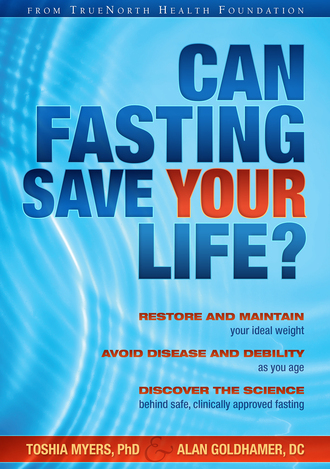Intermittent Fasting and Weight Loss
A form of calorie restriction, intermittent fasting may help you lose those extra pounds.
By Jennifer Marano, D.C.
For many people, following a whole-food, plant-based diet is the key to maintaining optimum weight and health. However, for some of us, strictly adhering to a health-promoting diet as well as engaging in a regular exercise program is not enough to keep us where we want to be weight-wise. We just like eating too much; or perhaps we have extremely efficient digestive systems; or our internal calorie counters are a bit off. Whatever the reason, I and many others tend to maintain a body weight 5 to 10 pounds heavier than what would make us look and feel our best. I have been trying various tricks for years—decades, really—to get rid of those final pounds, and I think I have finally found the answer: intermittent fasting.
I have been involved with fasting for over 30 years as co-founder of TrueNorth Health, a fasting and health center in Northern California, and I am very familiar with the tremendous benefits of fasting for maintaining or restoring optimum health. But we have never recommended fasting as a solution for weight loss. It may jump-start a weight-loss program by resetting our appetite so that we enjoy health-promoting food; but maintaining optimum weight is done by consuming a proper diet every day, not by prolonged fasting followed by a return to bad dietary habits.
But what is a “proper diet”? Is it the same for everyone? Over the past few years I have read a lot about the value of intermittent fasting, both for weight control and general health, and what struck me from the beginning is that the daily eating habits we follow in the developed world—three meals a day supplemented by coffee breaks, mid-afternoon pick-me-ups, and evening nibbles—is a very recent development in human history. For most of the world this abundance of food has not been available until very recently; and in undeveloped areas it is still not the norm. But just mention that you are skipping a meal here and there, and you are met with looks of horror and comments about how unhealthy that is.
But is it unhealthy? What happens when we don’t eat for a period of time? We know that when we eat more than we need to maintain our function, the excess is stored as fat. This is one of the adaptations we possess to keep us going during times of scarcity. When food isn’t available we burn our stored fat to keep us going until we can locate more food. We need certain enzymes to help us store fat and other enzymes to help us mobilize our fat stores. But if we are eating all day long there is never a time when we need to burn fat. It takes 8 to 12 hours to digest and assimilate the food from a meal, so most people in the developed world really never have to mobilize fat. And if the body doesn’t need to do something, it tends to not maintain the equipment (think enzymes) necessary to do that task. You know what happens to your muscles if you don’t exercise. And you know what you have to do to get back into shape. The ability to burn fat waxes or wanes in response to use, just as your muscles respond to use after exercise. You can develop the enzyme systems that allow you to switch easily from burning glucose to burning fat, but it takes some time. And while you are developing them you feel hungry; sometimes very hungry. And it is uncomfortable. Even after you develop these systems you still feel hungry (although it isn’t quite as uncomfortable). But it’s okay—feeling hungry is okay.
What is Intermittent Fasting?
So what is intermittent fasting (IF)? How does it apply to humans? Why do it? What can it do for you? And how do you do it?
IF is a form of calorie restriction, which has been studied for a long time, mostly in animals like rats and mice. It was observed that animals fed a restricted diet lived a lot longer than animals allowed unlimited food. There are people who are practicing calorie restriction with the hope that they will greatly extend their lives. But it is a very uncomfortable way to live, and these people can become very gaunt and weak. Not very many are successful at maintaining this lifestyle. The difference between IF and calorie restriction is the “intermittent” part. Yes, calories are restricted, but only some of the time. And recent animal studies have shown that the benefits are actually greater for the intermittent fasters than for those on a calorie-restricted diet; they both live just as long, but the intermittent fasters don’t lose muscle mass or become stunted. And that makes all the difference when it comes to applying the idea of IF to human health and weight control.
Before getting into the various types of IF, I would like to say a little about the physiological changes that occur with IF and how they impact health. One change is that the level of insulin-like growth factor 1 (IGF-1) goes down. High levels of IGF-1 in adults are associated with accelerated aging and development of cancer, so lowering this factor may be one explanation for the life-extension effects seen in animal studies. In addition, genes whose function is to repair are turned on by fasting. An organism needs to be in top shape during times of scarcity in order to successfully find food, so the stress of the fast causes this activation, much as the stress of drought or insect pests causes plants to produce more antioxidants. And a third effect is increased insulin sensitivity. Insulin resistance is associated with type 2 diabetes, and high levels of circulating insulin lead to excessive fat storage. Keep these physiological changes in mind as we discuss the various forms of IF; it will increase your understanding of why IF works for weight loss and also why it can be a healthy lifestyle choice, even after you have reached your ideal weight.
The Alternate Day Fasting Plan
One popular form of IF is “alternate day fasting” (ADF, or ADMF for “alternate day modified feeding”). The modified feeding title refers to a system developed by researcher Dr. Krista Varady of the University of Illinois at Chicago. In her system the fasting days actually involve eating a small meal (500 calories for women and 600 calories for men), while feeding days allow unrestricted eating. Dr. Varady found that, contrary to expectations, her subjects did not go crazy on feeding days. They tended to eat about 110% of what they would eat on a normal day before beginning ADMF. This makes ADMF a very effective weight loss program, but it has its difficulties, particularly socially. Friends and family have a hard time keeping track of when you are feeding and when you are fasting. But it is a good choice for people who have a large amount of weight to loose.
The 5:2 Plan
A more easily followed, yet still very effective version of IF is the “5:2 plan,” which was popularized by Dr. Michael Mosley with his Horizon TV program on BBC and in his excellent book, The Fast Diet. On this plan you choose two fast days a week (perhaps Monday and Thursday) when you will eat 500 to 600 calories. The other five days you eat whatever you want, but preferably a health-promoting diet. This plan has been studied extensively. In one study by Dr. Michelle Harvie in Manchester, England, three groups of women were compared for three months. Group 1 was asked to eat 1,500 calories a day on a Mediterranean diet. Group 2 followed a 5:2 plan, eating 650 calories of low-carbohydrate food on the two fast days. Group 3 was asked to avoid carbs two days a week, but was not given any specific calorie target. At the end of three months the 1,500-calorie group lost an average of 5.28 pounds, and the 5:2 groups lost an average of 8.8 pounds!
The Restricted Eating Window Plan
A third version of IF, perhaps the easiest to follow, is the “restricted eating window plan.” This method was based on a mouse study at the Salk Institute for Biological Studies where two groups of mice were each fed an unhealthy, high-fat diet. Each group received the same amount of food, but one group had constant access to the food, while the other group had to do all their eating in an eight-hour period each day and fast for the remaining 16 hours. After 100 days the “unlimited” group had high cholesterol, high blood glucose, and liver damage, while the “fasting” group put on 28% less weight and suffered less liver damage. The fasting group also had lower levels of inflammation, which we are learning is a very important factor in heart disease, cancer, stroke and even Alzheimer’s disease.
Intermittent fasting can be a powerful weight-loss tool with a bonus of improving your overall health. You can design your own program depending on your goals: ADMF if you have a lot of weight to lose, 5:2 as you get closer to your goal, and you can try a 6:1 plan when you get to your optimum weight so you can continue to reap the physiological benefits of IF. Or restrict your eating window to six or eight hours. If you get a bit off track you can throw in a 500- to 600-calorie day here and there. This approach is endlessly flexible—you just have to figure out what works best for you! And just remember: it’s okay to feel hungry.
Jennifer Marano, D.C.


